Illustrated Review: Breaking down the options on the Bruins' top line wing

Since he broke into the NHL in 2009, Boston Bruins forward Brad Marchand has skated nearly 4,500 minutes with Patrice Bergeron at even strength. That accounts for over 75 percent of Marchand's 5v5 time, and, as the two have played more and more together, they've become one of the best forward duos in the league.
But in the NHL, it takes three to tango on a forward line, and the Bergeron-Marchand line has seen many third wheels.
The two wingers that logged the most time next to Bergeron and Marchand are still in the league, but no longer on the Bruins' roster: Tyler Seguin and Reilly Smith. Both players were traded, each acquisition ostensibly acquiring a player who could slot in on the Bruins' most effective line in Loui Eriksson (Seguin trade) and Jimmy Hayes (Smith trade).
In his three seasons in Boston, Eriksson bounced around the line chart but rented considerable minutes with Bergeron and Marchand. Hayes, still under team control, has been a healthy scratch through stretches, and through others, has filled more of a bottom-six role. When Eriksson hit free agency this past summer, he signed a big-money deal with the Vancouver Canucks, again leaving a vacancy in the unit that has been subletted in Bergeron and Marchand's complex.
Illustrated Review: Maple Leafs’ power play reinvigorated by shot volume, new talent
Then this summer, the Bruins signed veteran forward David Backes to a five-year deal. Also among its offensive weapons was David Pastrnak, a third-year forward who turned 20 last May following a sophomore season that saw him score 15 goals in 51 games played while averaging under 14 minutes of ice time.
Bergeron and Marchand are not only the engine that makes the Bruins' offense run, they're also the gasoline, the tires and the wiper fluid, et al. On what's been an offensively starved team—16th in 5v5 goals per game, and 24th in 5v5 shooting percentage—the Bruins lack for getting offense from different sources has been problematic.
It became such an issue that Feb. 7 the Bruins fired coach Claude Julien. There was a major discrepancy between how many goals Boston was generating versus what the underlying numbers portended them to produce. At the time of Julien's firing, Boston was seventh in the NHL with just over 110 expected goals-for. By contrast, it had scored 87 times, the 23-goal gap the widest in the NHL, with the Buffalo Sabres the next closest at the time at 17.
And in the midst of all this, like any team struggling to score has and will continue to do, the Bruins juggled their lines. Boston has scored two or fewer goals 34 times this season, tied for 12th most in the NHL. Of the 11 teams to have scored two or fewer on more occasions than Boston, the Montreal Canadiens, the Ottawa Senators, and the Anaheim Ducks currently hold playoff spots. Boston is 11-22-2 when it fails to score three goals.
What all of this amounts to is a need to maximize offensive capabilities with the pieces it has. Marchand leads Boston with 33 primary points at 5-on-5, with Pastrnak second at 31, followed by David Krejci (25), Backes (19), and Bergeron (19), according to Corsica.Hockey. Those will be Boston's only players to eclipse 20 primary even-strength points.
The question facing left to interim coach Bruce Cassidy is who among Backes or Pastrnak will play with "Bratrice" and who will slide onto the second line with Krejci.
The bulk of Pastrnak's minutes with Bergeron and Marchand have come this season, when he's played 495:55 with the two forwards, compared to the 73:35 he skated with them at even-strength combined over the past two seasons.
The line's underlying numbers have also improved and done so over an extended sample.
So that latter row, the one with this season's numbers, is the more statistically meaningful. The goals-for percentage is sky-high in the first, shorter sample because the line scored twice, while being scored against once. But with Pastrnak, Bergeron and Marchand's line has better possession numbers than it did with Seguin, or Smith, though the scoring rate is a bit down.
With Backes, the scoring rate is up, and in fact 13th in the NHL in goals-for per 60 for line combinations that have skated a minimum of 200 minutes together, according to Corsica.Hockey.
And maybe there's not a right answer, but it's a question that has and continues to persist for the Bruins. Last week Fluto Shinzawa had this on the topic in The Boston Globe:
"No coach, including Cassidy, would sprint to splinter the best 200-foot line in the league. But after he replaced Claude Julien, Cassidy believed taking Pastrnak away from Marchand and Bergeron would serve the lineup best. The Bruins were too top-heavy with the trigger-happy Pastrnak winging pucks alongside the possession monsters. At the same time, Krejci and Backes had not developed consistent chemistry in any of the three zones."
Taking Pastrnak off the line, which first happened back in December, was spurned by that same search for offense, which, as Shinzawa wrote, led Julien to re-cast Pastrnak in the hopes he could blaze a new offensive trail on a different line.
Illustrated Review: Searching for a link between face-off wins and longterm success
"It was a tough decision to make, but the right one for now because of the team’s lack of secondary scoring. Pastrnak is playing well enough to create chances with anybody. Backes, on the other hand, has had 21 games with Krejci. Neither of the right-shot forwards has created consistent offensive chances."
There's a stark contrast in playing style between Pastrnak and Backes. The former is an up-tempo, highlight-reel-waiting-to-happen skater who can make something out of nothing, whose star is on the rise.
Backes, a 10-year veteran, is a prototypical power forward. He can retrieve pucks on the forecheck, though that is an area both Bergeron and Marchand are deft in. What you see from Backes is what you get.
Each brings a different ingredient to the Bergeron-Marchand line, with the prevailing question of which best complements a recipe for offense.
Carbo-Loading
In Pastrnak, Bergeron and Marchand have a sidekick who won't miss a beat, pace-wise. In his third year, Pastrnak is having one of the most productive 20-year-old seasons of the past 20 years.
Pastrnak's stock is on the rise, and, headed to restricted free agency this summer, his second NHL contract will command a raise from its current $925,000.
On the ice, Pastrnak can command attention, but playing with Bergeron and Marchand he can also fill a complementary role, one where he can take advantage of the space his linemates create. On this goal against the Toronto Maple Leafs, Pastrnak ends up in open pastures after a neutral zone turnover leads to a transition opportunity.
When the Bruins gain possession, Pastrnak is stationary in the bottom of the frame. Zdeno Chara quickly pushes the puck up to Bergeron, but Toronto has three players back. Pastrnak quickly gets his legs, catching up to his linemates.
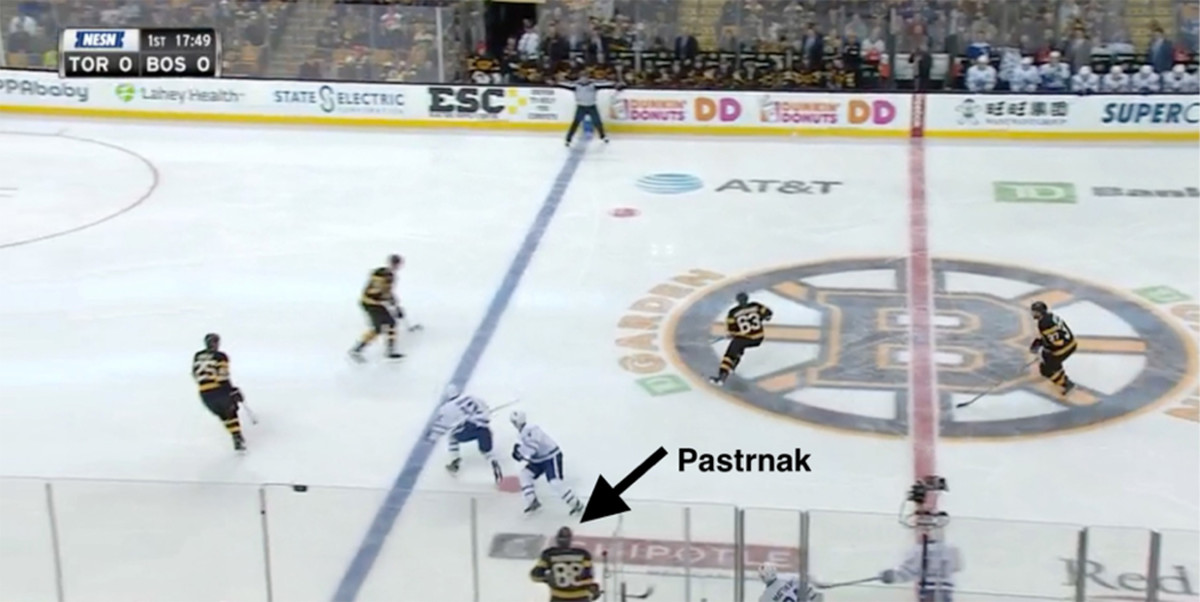
When Bergeron hits the offensive blue line, every Maple Leaf is focused on him and the puck. Still in the same lane as when the puck turned over, Pastrnak is unattended, free to slip in the zone while the defense collapses on Bergeron. Pastrnak plays off the spacing and takes advantage of the width of the ice.
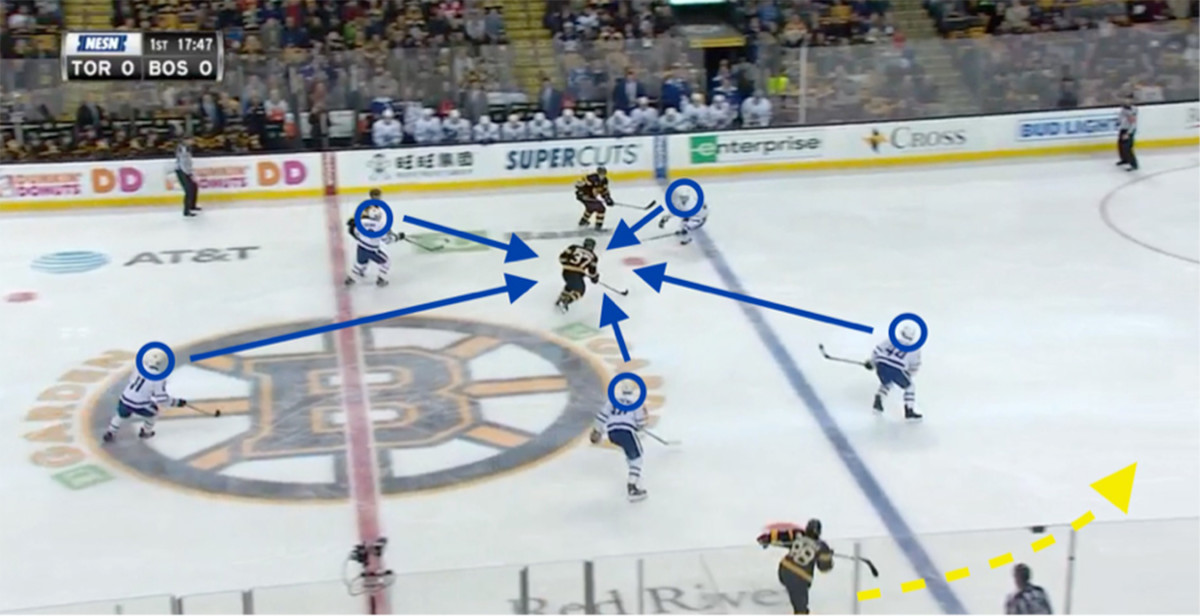
Pastrnak takes Bergeron's pass in stride, and breaks in alone on Frederik Andersen. He keeps his head up, and identifies an opening, though it takes a good shot to fit it there.
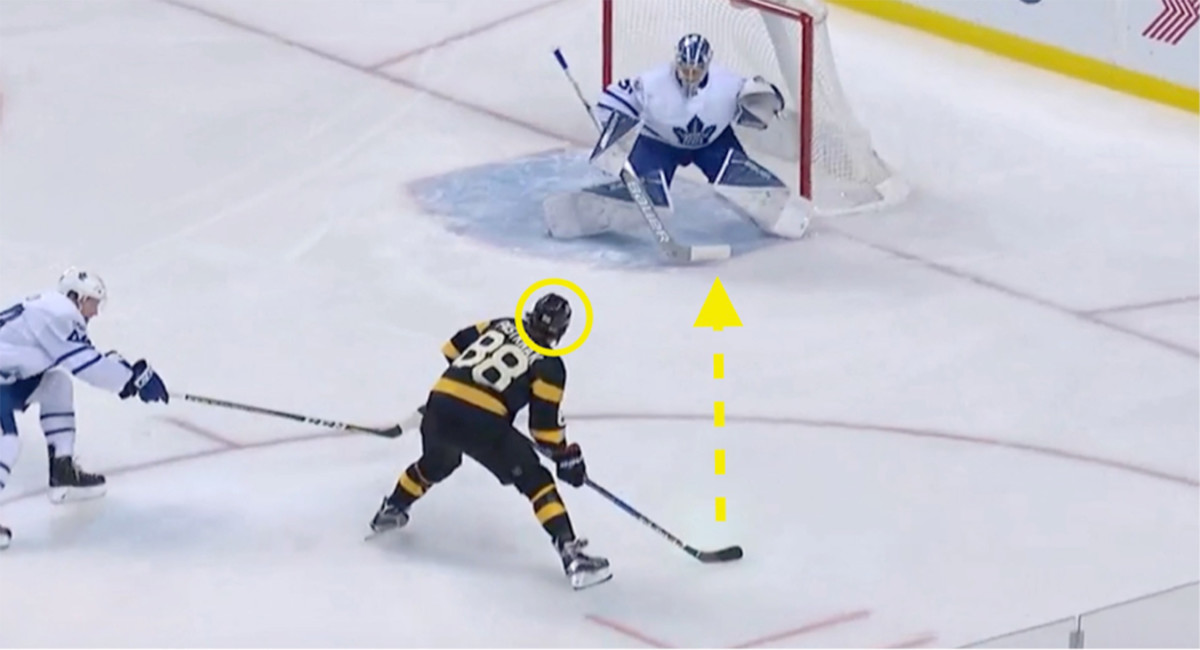
Playing off the puck is something a forward has to do with Bergeron and Marchand. On this goal, the Bruins execute a set play off the faceoff that puts Pastrnak in a shooting position atop the circle.
The first piece of this sequence, much like the rest of it, is simple. Bergeron wins the puck to Pastrnak, who in turn plays it back to Torey Krug at the right point.
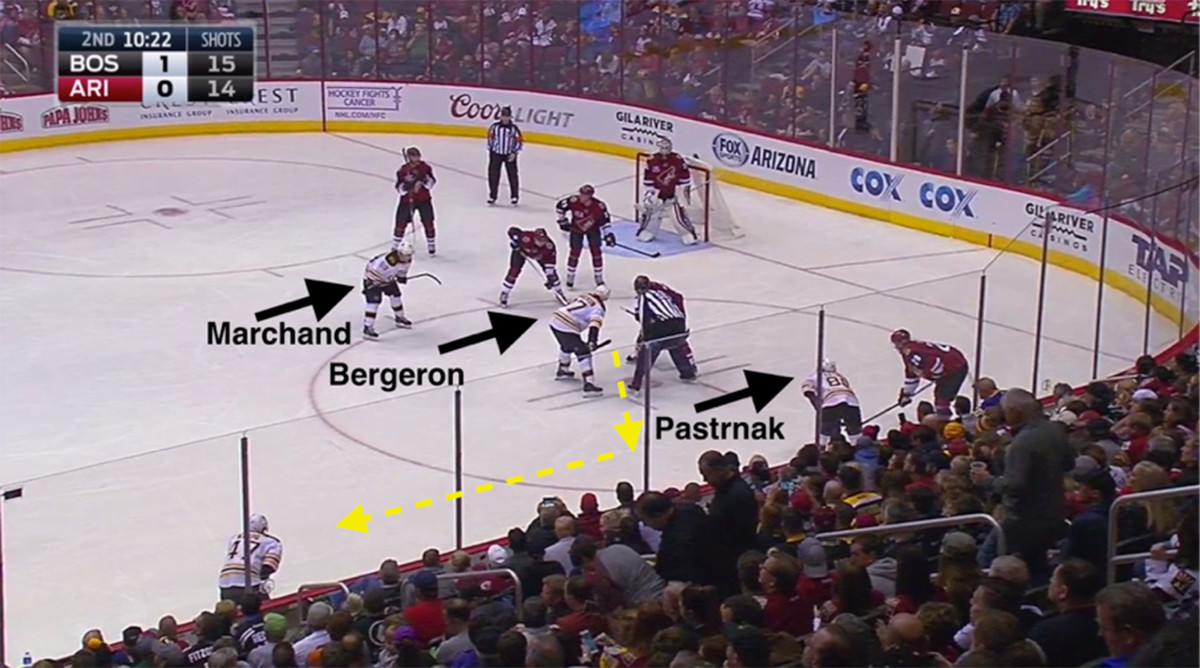
Though things begin to get complicated for the Coyotes at this point, the Bruins are just moving bodies and creating natural interference. The players' names indicate where they were positioned for the faceoff, while the arrows map their routes. After Pastrnak plays the puck back for Krug, he sinks to the top of the circle. Marchand cuts from one hash across the faceoff circle toward the wall. Bergeron curls off the dot and toward the goal. In unison these movements muck up the space in the middle of the ice, making it more difficult for Coyotes to defend tightly.
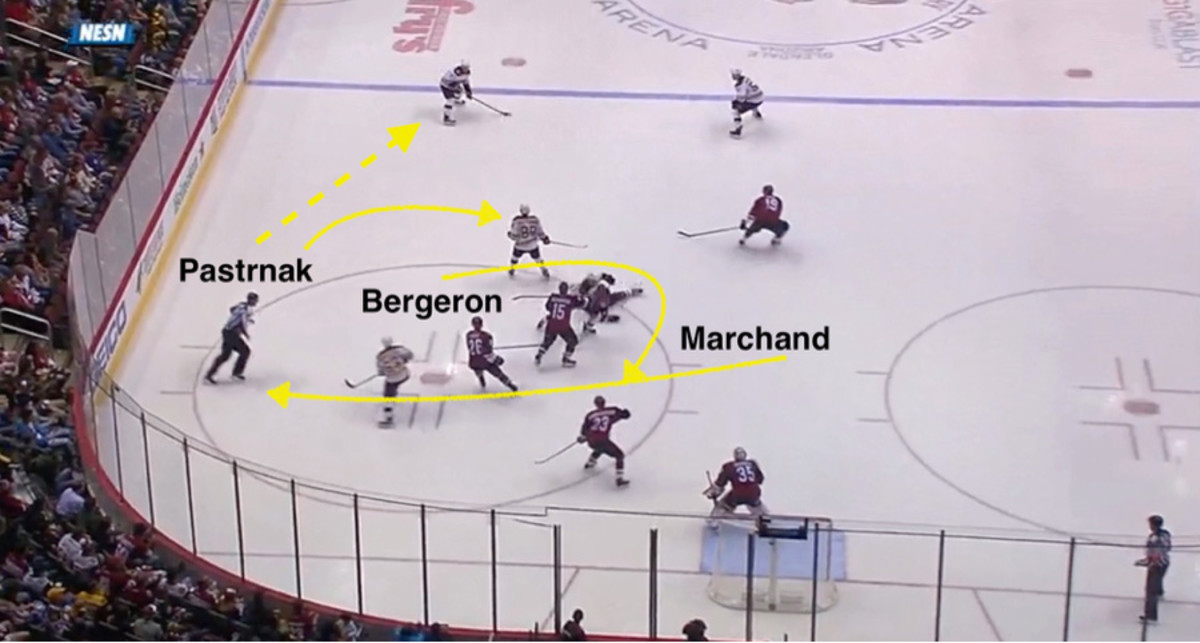
The end product sees Pastrnak in a shooting spot in the high slot, separation created by all the criss-crossing. Bergeron, who cut to the goal, skates past Louis Domingue right as Pastrnak contacts the puck. Pastrnak has a very good shot, one that can be created on a line with the likes of Marchand and Bergeron.
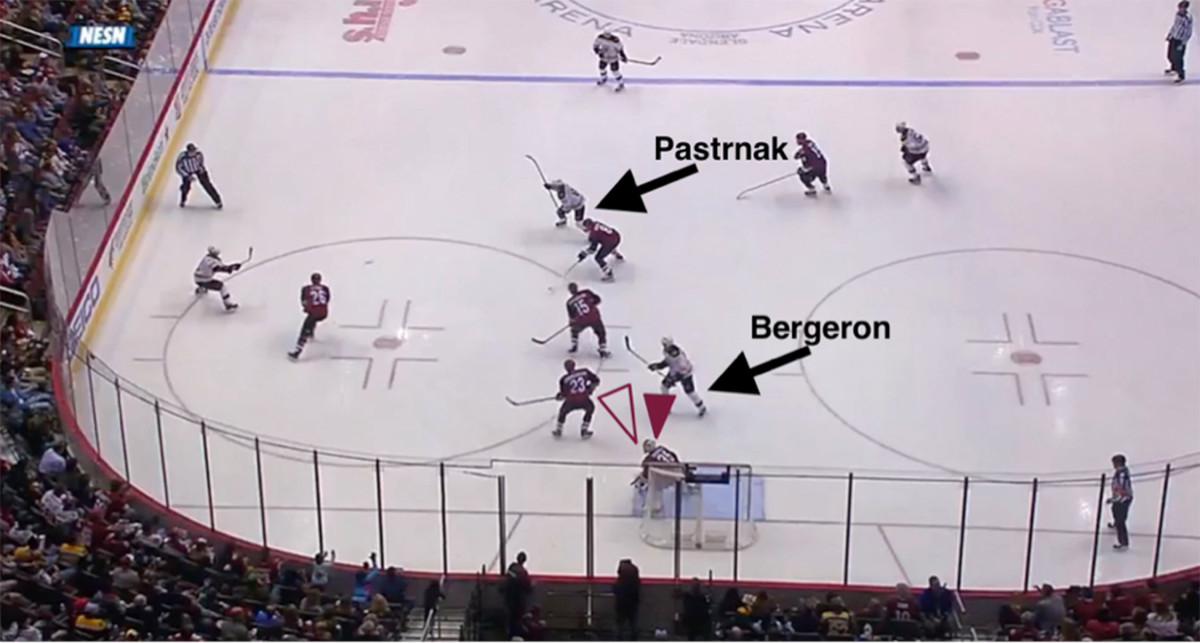
Back-to-Backes
Where Pastrnak can and is expected to play above the hashmarks, Backes is expected to be active down low. Be it on the forecheck, going to the net, or getting in a shooting position, they're areas and aspects Pastrnak is not expected to fill.
On this goal against the Vancouver Canucks, Backes is the beneficiary of a good bounce he created by driving to the crease.
This is a simple 2-on-2 at the blue line. With Backes in the middle of the frame, his job here will always be to drive the net to either play a rebound, create traffic or drag the defense with him, leaving space for the trailer, in this case Marchand.
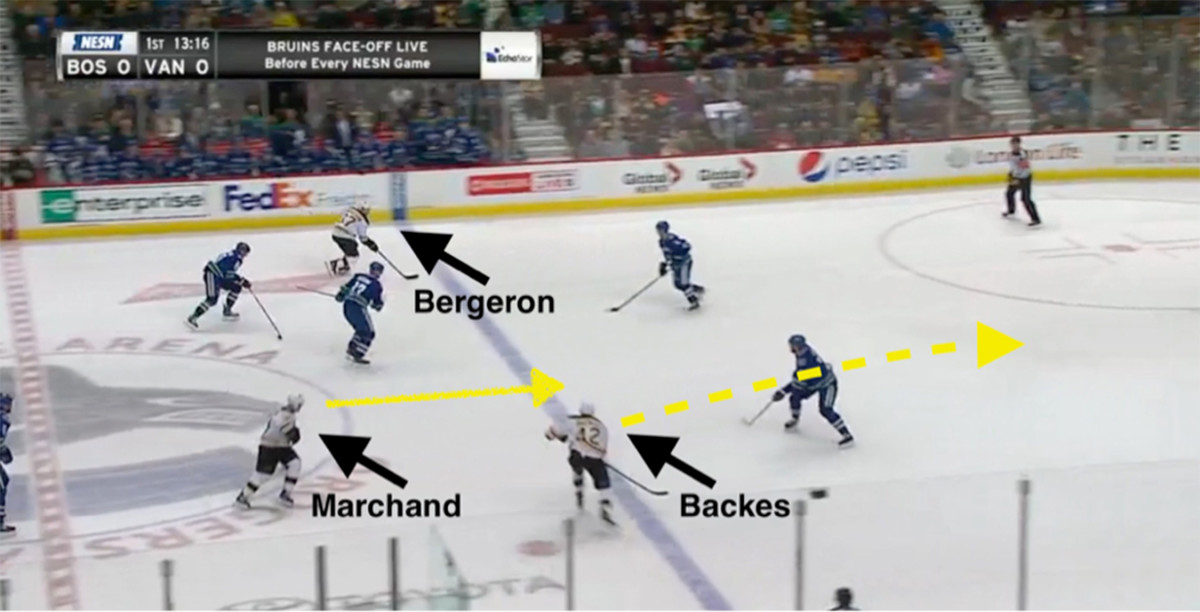
Bergeron takes a long-distance shot, and Backes powers his way to the front. Though he isn't the first player to the spot, he swims inside Canucks defenseman Alex Edler, in turn giving Bergeron a target.
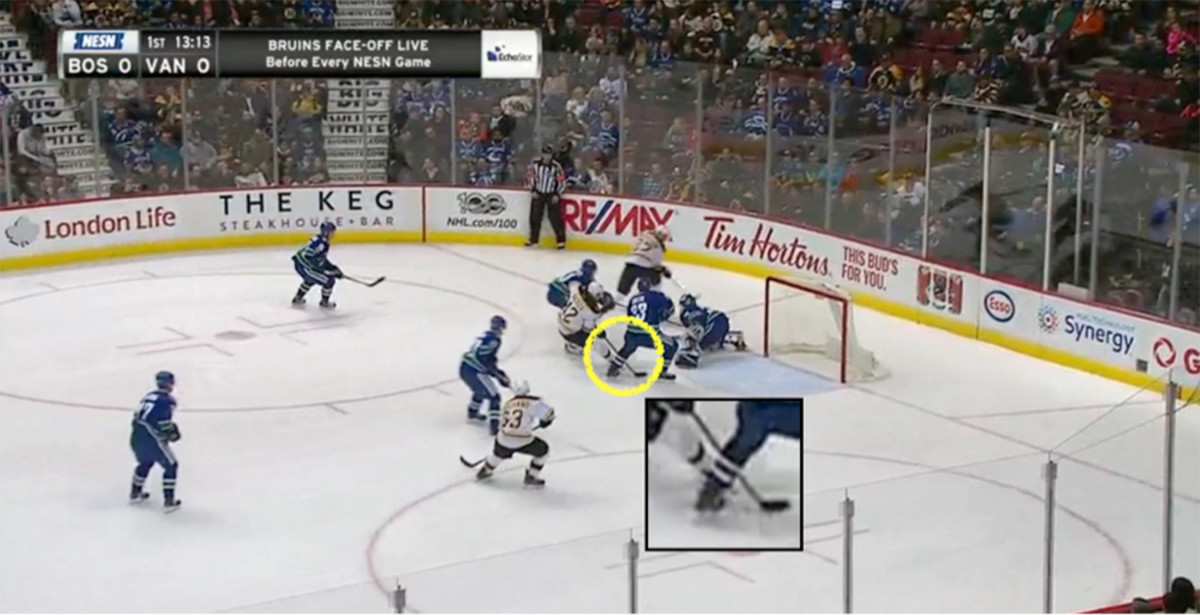
Everything aligning for Bruins’ Pastrnak in breakout season
When Bergeron plays the rebound toward the net mouth, Backes has his stick on the ice, and his body anchored so that Edler can't make defensive play through the puck.
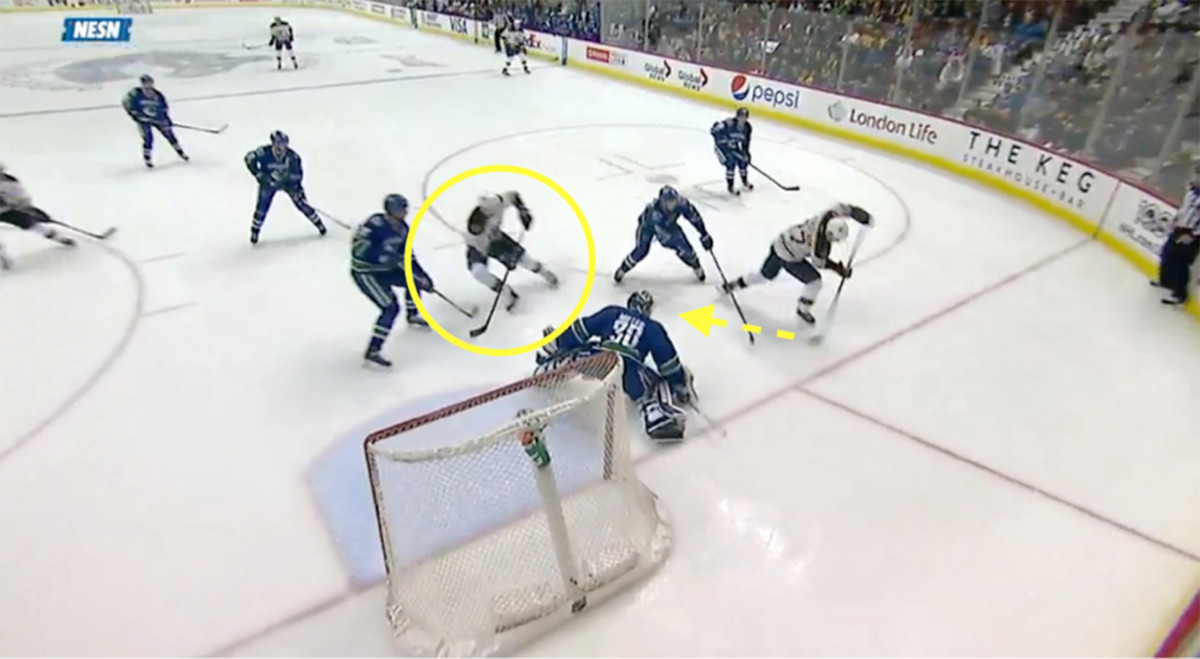
This line has been a constant driver-of-play for the Bruins, and any appreciable sample it has with a third forward has turned in glowing results. If it's Pastrnak or Backes playing to the right, the trio will succeed.
But with Boston in the midst of a dogfight for a playoff spot—three points behind Toronto for third in the Atlantic after Thursday, two points clear of the Islanders for possession of the second wild card spot, with the teams bookending them in the standings each with a game in hand.
So every game, every period, and every shift is more important than the last for Boston, who has now lost consecutive games to those Leafs and the Ottawa Senators in which they scored a combined four goals, and one at 5-on-5.
With the Bruins attempting to extend their residency into the 2017 Stanley Cup Playoffs, finding the right winger to rent on its top line could go a long way in extending Boston's lease on its season.
